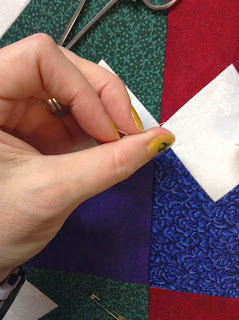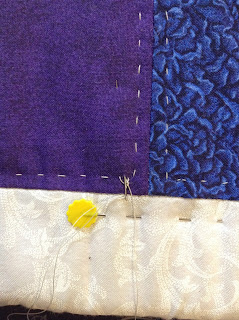Here's a fairly simple idea for a Christmas present. This is what Gideon's giving to Fiona. I'm sure you've seen the tied fleece blanket kits where you buy the pre-cut squares of fleece with the edges cut into fringe that you tie together to make a blanket. You can make it yourself. (Click here to go to the tutorial on how to finish the blanket as well as things I learned in the process of helping Fiona put it together).
I bought a special June Taylor ruler that has long slits in the plastic for the rotary cutter to make even cuts with. This of course could be done without the fancy ruler, but I figured the price of the ruler was about the price of the kit and I would be able to make however many I wanted and whatever size I wanted. I'm glad I bought it since I'm a perfectionist and wanted the fringe to be exactly the same width and size. Let me show you how I did this.
First start with fleece - I used scraps left over from other projects so there was no extra monetary cost to this gift. Each square I cut into a 12" square. With 2" fringe on all sides, the final area will be an 8" square. You can make it whatever size you want, but you do want to allow enough fringe to be tied. Most instructions I found for tied fleece blankets were for the kind with fringe only around the outer edge. Each instructed you to have 3-4" per side for the fringe. But when I did the math for the boxed set at the store, they allowed only 1.75" per side for the fringe. I figured that having really long fringe all over the blanket might be excessive, but you can do it however you want - just figure that into your cutting size. The 12" size fit under the ruler perfectly - a bonus I had not planned on but was glad for.
Next I centered the ruler over the square. Because I was cutting 2" fringe, I began cutting the fringe 2" from either edge and cut close to, but not over the 2" line. It's much easier to even the cuts with scissors that to end exactly where you want with a rotary cutter. I cut the fringe 1" wide - mostly because it was easiest and I'm lazy at heart. You could do it less than that, but I wouldn't go bigger or it would give more puckers in the fabric between each knot. The kit they sell pre-made has 1/2" cuts which has its advantages and disadvantages. If you want my pros and cons list, just ask.
After the initial cutting on all 4 sides with the rotary cutter, slide the ruler up to the bottom cuts on both sides, lining up the edge of the ruler exactly. With a sharp pair of scissors, cut each of the fringe up to the edge of the ruler. I cut the bottom, then slid the ruler down, turned the cutting mat around and cut the top. Then did the left and right, always turning the mat around so my cutting would be at the bottom, nearest to me. If you can help it, don't move the fabric once you lay it out, it's so much harder to square it up again.
When you cut the two sides, the corners will be cut off. That is as it should be. Now repeat for all the squares. I tried doing two at a time and it worked, but my hand was really sore from the rotary cutting by the end of the day. As my dad used to say, "Lazy people work the hardest." I'm living proof of that.
To put together, simply place 2 pieces next to each other and tie the fringes together using square knots (right over left, left over right). You do want to tie them securely, but if you pull the first part of the knot too tight, it's going to pucker and not lie flat. Keep tying them together until you have a nice sized throw blanket. 48 squares (6x8) will give you a blanket that is 48"x 64." Maybe after Christmas when Fiona begins to make it, I can take some pictures and put a little tutorial up about putting it together. Right now it's wrapped and under the tree.
I bought a special June Taylor ruler that has long slits in the plastic for the rotary cutter to make even cuts with. This of course could be done without the fancy ruler, but I figured the price of the ruler was about the price of the kit and I would be able to make however many I wanted and whatever size I wanted. I'm glad I bought it since I'm a perfectionist and wanted the fringe to be exactly the same width and size. Let me show you how I did this.
First start with fleece - I used scraps left over from other projects so there was no extra monetary cost to this gift. Each square I cut into a 12" square. With 2" fringe on all sides, the final area will be an 8" square. You can make it whatever size you want, but you do want to allow enough fringe to be tied. Most instructions I found for tied fleece blankets were for the kind with fringe only around the outer edge. Each instructed you to have 3-4" per side for the fringe. But when I did the math for the boxed set at the store, they allowed only 1.75" per side for the fringe. I figured that having really long fringe all over the blanket might be excessive, but you can do it however you want - just figure that into your cutting size. The 12" size fit under the ruler perfectly - a bonus I had not planned on but was glad for.
Next I centered the ruler over the square. Because I was cutting 2" fringe, I began cutting the fringe 2" from either edge and cut close to, but not over the 2" line. It's much easier to even the cuts with scissors that to end exactly where you want with a rotary cutter. I cut the fringe 1" wide - mostly because it was easiest and I'm lazy at heart. You could do it less than that, but I wouldn't go bigger or it would give more puckers in the fabric between each knot. The kit they sell pre-made has 1/2" cuts which has its advantages and disadvantages. If you want my pros and cons list, just ask.
After the initial cutting on all 4 sides with the rotary cutter, slide the ruler up to the bottom cuts on both sides, lining up the edge of the ruler exactly. With a sharp pair of scissors, cut each of the fringe up to the edge of the ruler. I cut the bottom, then slid the ruler down, turned the cutting mat around and cut the top. Then did the left and right, always turning the mat around so my cutting would be at the bottom, nearest to me. If you can help it, don't move the fabric once you lay it out, it's so much harder to square it up again.
When you cut the two sides, the corners will be cut off. That is as it should be. Now repeat for all the squares. I tried doing two at a time and it worked, but my hand was really sore from the rotary cutting by the end of the day. As my dad used to say, "Lazy people work the hardest." I'm living proof of that.
To put together, simply place 2 pieces next to each other and tie the fringes together using square knots (right over left, left over right). You do want to tie them securely, but if you pull the first part of the knot too tight, it's going to pucker and not lie flat. Keep tying them together until you have a nice sized throw blanket. 48 squares (6x8) will give you a blanket that is 48"x 64." Maybe after Christmas when Fiona begins to make it, I can take some pictures and put a little tutorial up about putting it together. Right now it's wrapped and under the tree.




































































